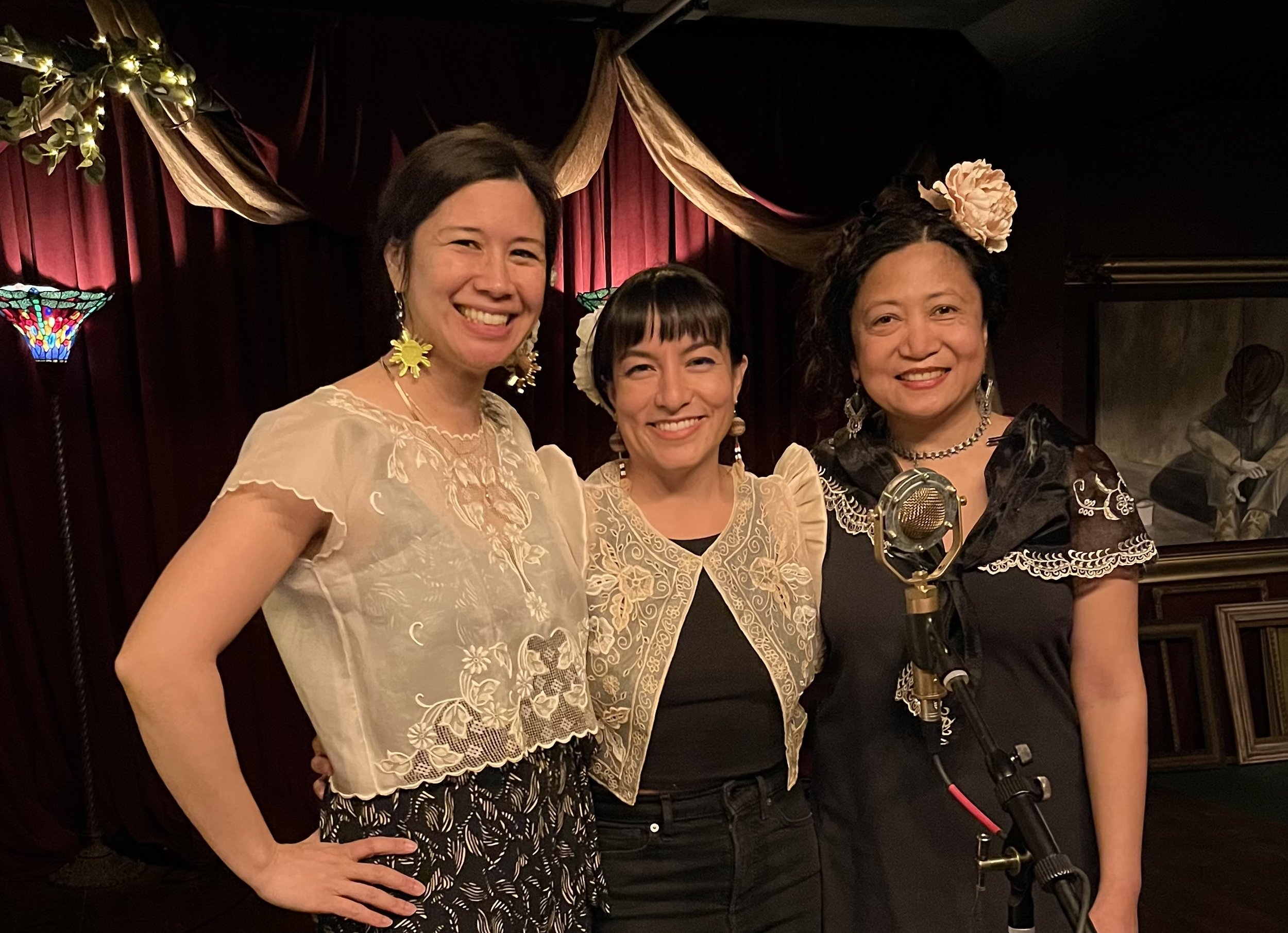Singing Tagalog Favorites with a Touch of Fil-Am
/The Sampaguitas at the Lost Church, San Francisco
The ten-track CD brings new interpretations to old Filipino favorites, bringing a beautiful – often surprising – blend of influences, from traditional folk, to pop, jazz and blues.
The trio consists of Aireene Espiritu, Jenevieve Francisco, and Cristina Ibarra. “We each come from different experiences and familiarity with the language,” explains Ibarra. “But getting to sing and learn Tagalog feels like stepping into a river that flows back to our ancestors. Singing these songs with my Sampaguita sisters is like creating our own connection to the country of our roots, and standing proudly in our Pinay heritage,”
Of the three, Espiritu is the only one born in the Philippines and grew up speaking Tagalog and Pangasinan. Though Ibarra heard Tagalog throughout her childhood as her grandparents housed many family members arriving from the Philippines, she found it difficult to learn the complicated language in college classes. It was not until she started singing that the music “unlocked the language” for her. “I was able to feel the meaning through the phrasing and the melodies,” she says.
The group has only been together for a year – but a whirlwind of a year, with many performances and the launch of their first CD. Francisco works as an activities director at a senior residence in Oakland, and they first got together to sing for a Hootenanny there in honor of Filipino American History Month last year.
The Sampaguitas at Casa de los Sentidos during a Mission Arts & Performance Project event, San Francisco
“We sang only one song, Oras Na,” Francisco recalls, “but we were so pleased with the sound and the audience reaction that we decided to try more songs.” Fortuitously, the founder of The Little Village Foundation saw a video of the performance snd he immediately decided to record the group’s first album.
They realized that as Filipinas living in the U.S. they were part of both cultures – and of a third one: being Fil-Am. During rehearsals, they would converse in Taglish, share jokes, family stories and Filipino food. “Kare-kare” is my favorite,” Francisco laughs, “and ube desserts!”
They chose the name Sampaguita because the national flower of the Philippines seemed a perfect symbol to describe the sweet sounds coming from their melded vocal textures, tones, and tight harmonies.
The Sampaguitas after a show (Photo by Kat White)
Espiritu, a multifaceted professional musician with four highly-acclaimed albums, has performed at many clubs and festivals, including Hardly Strictly Bluegrass and the Yerba Buena Gardens Festival and sang with the Glide Memorial Church Gospel Choir. “I fell in love with music when my uncles would play guitar in our living room in a finger-picking style.” Her musicianship has been widely praised, including by the Los Angeles Times, which noted her “impressive blend of atmosphere and message.” When she stumbled upon Alan Lomax’s field recordings of vernacular American musicians, she learned to sing and play in many different styles.
Francisco and Ibarra were part of the Hitsville Soul Sisters band, which was influenced by The Supremes and other legendary girl groups. They added a Motown style to the mix.
When the three started singing together, they were thrilled by the synchronicity of their voices and the unique harmonies they were able to create. Their camaraderie is reflected in their music. “Honestly, I didn’t know where my voice ended and theirs began!” Francisco says.
Their eclectic musical background has brought new, unexpected arrangements to classic Filipino songs like Dahil Sa Iyo and Bahay Kubo. Their rendition of the political anthem Bayan Ko, is heart-wrenching, with gorgeous harmonies and an elegant flute solo by guest artist John Calloway.
The album also includes original compositions like Espiritu’s Mama Did Her Best, a tribute to her single mother “an immigrant who worked three jobs to provide for my brother and me.” That love is conveyed in a country music style, with a chorus of “shoo-bop-shooby-doo-Mama!” Cristina Ibarra’s bilingual My Sampaguita, asks, “Where do you come from? Where are you growing?” It seems a fitting metaphor for The Sampaguita’s journey of discovery.
The Sampaguitas CD was produced by The Little Village, an arts non-profit that shares multicultural music with American roots to increase cross-cultural understanding. All proceeds go to the artists.
To listen to the Sampaguitas: https://music.apple.com/us/album/folk-songs-from-the-philippines-and-beyond/1708953837
Their next Bay Area performance is at the Freight Fest of Freight and Salvage on October 14, where they will be part of the Little Village stage lineup: https://thefreight.org/fest/
The CD is available at https://bit.ly/TheSampaguitas
Album cover designed by Maurice Tani for Little Village Foundation
Elaine Elinson, co-author of “Wherever There’s a Fight: How Runaway Slaves, Suffragists, Immigrants, Strikers, and Poets Shaped Civil Liberties in California,” represented the United Farm Workers in Europe during the international grape boycott.
More articles from Elaine Elinson







